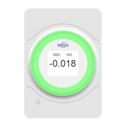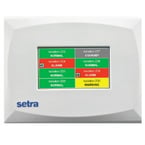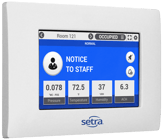In the post COVID-19 world, new applications for negative pressure spaces have begun to emerge and negative pressure ventilation is mentioned throughout OSHA and CDC guidelines. No longer strictly meant for airborne infection isolation rooms in hospitals, negatively pressurizing a space can help businesses and other facilities safely resume operations. These new applications include dental, mortuary, long-term care facilities, and nursing homes. In long-term care facilities, creating an isolation wing using negative pressure can be an effective and efficient way to further reduce the spread of dangerous particles and increase the effectiveness of the isolation. A designated isolation area for suspected or confirmed COVID-19 patients helps limit the possibility of contamination and spread throughout a nursing home or long-term care facility. In spaces like dental offices, that commonly deal with aerosol generating procedures, it is crucial to negatively pressurize certain rooms to prevent the spread of airborne infection.
Some key parameters to monitor when increasing ventilation or creating a negative pressure space include air changes per hour (ACH) and differential pressure. The CDC recommends 12 ACH in a space where a procedure creating airborne viral particles is performed. Another requirement for these rooms includes negative air pressure relative to the outside reference area, a difference of at least -0.01” WC.
Establishing a Negative Pressure Room
There are several methods to quickly create a negative space. First, minimize the number of people entering and exiting the space. Second, create a barrier. If the area has a door, block any gaps to help create a seal. If it’s an open area, block off the space with a heavy plastic curtain. Third, bring in a portable unit to pull a negative pressure and exhaust the contaminated air out. Ideally, the air is exhausted away from any area where people pass by outside. Incorporating a portable high-efficiency particulate air (HEPA) filter with the portable unit will help reduce particle counts in the air without relying solely on the building’s HVAC system. In addition to HEPA filters, consider using ultraviolet germicidal irradiation (UVGI) for sterilization of the air being pulled by the portable unit.
Setra's AIIR Watch negative pressure machine features UV/HEPA filtration and has an exhaust function to create effective negative pressure (and isolation) in virtually any indoor space.
An existing HVAC system can also be used to create a negative pressure space, although this method is more involved and requires more investment. Work with a local mechanical contractor or HVAC system engineer to adjust an HVAC system to ensures clean air is drawn into the room and contaminated particles, such as those from aerosol generating procedures or patients in isolation, are not able to escape. Traditional airborne infection isolation rooms in hospitals do not recirculate exhaust into the facility’s main HVAC system. Rather dedicated duct work filters the air through a HEPA filter before it is vented by stack on the roof so atmospheric air can dilute it. When adjusting an HCVAC system, be sure the contaminated exhaust has a path to leave or be sterilized and isn’t recirculated into clean spaces.
Monitoring Negative Pressure

With a newly pressurized space, it is crucial to have sufficient monitoring to ensure safe environmental conditions. Setra Lite is a visual pressure indicator that glows green when the space is safe. It can be mounted inside or outside the room, depending on the building’s layout and the user’s preference. Quick mount kits are available for even faster installation.

Setra’s MRMS, or Multi-Room Monitoring Station, can monitor the status of multiple pressurized spaces at a centralized location, like a nurse’s station. The MRMS can display conditions for up to eight rooms with configurable audible/visual alarms.
 Setra FLEX has advanced monitoring and control capabilities for deeper insight into the conditions in a pressurized space. On FLEX, up to 3 rooms can be monitored from a single unit. FLEX can monitor and display pressure, temperature, humidity, and air changes per hour as well as send control signals to HVAC or building automation systems for real-time adjustments based on the room’s conditions.
Setra FLEX has advanced monitoring and control capabilities for deeper insight into the conditions in a pressurized space. On FLEX, up to 3 rooms can be monitored from a single unit. FLEX can monitor and display pressure, temperature, humidity, and air changes per hour as well as send control signals to HVAC or building automation systems for real-time adjustments based on the room’s conditions.
As places like dental offices re-open and long-term care facilities evaluate their infection control strategies, there are many factors to consider. Understanding the various ways these new applications can create and monitor negative pressure spaces is an important aspect of safe and effective future operations.



